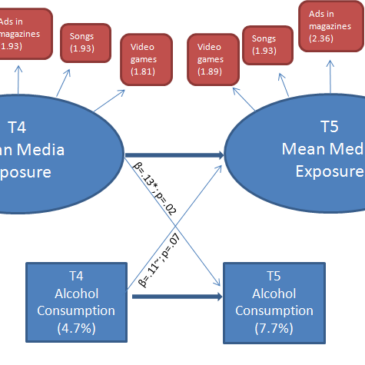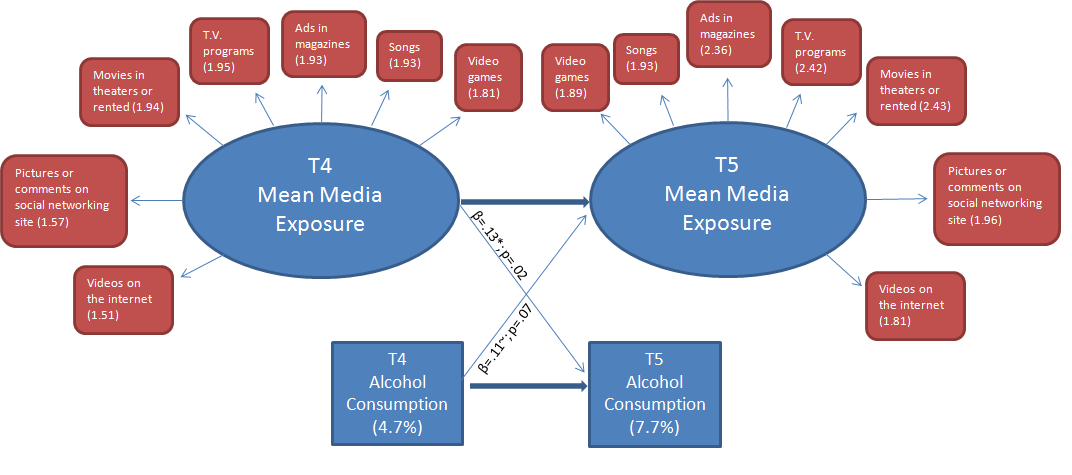As youth spend more time using social media and social networks via computers and smart phones, parents often worry about the content they are viewing: And with good reason. Studies have found associations between exposure to substance-related media content and substance using behaviors (e.g., Litt & Stock, 2011). Continuing the BASIS Special Series on Addiction and Technology, this week’s edition of The DRAM reviews a longitudinal study by Tucker, Miles, and D’Amico (2013) testing a shared relationship between social media alcohol-related exposure and alcohol use behaviors in middle school students.
Methods
- Researchers conducted a 5-wave longitudinal study over the course of 2.5 years to examine associations between media exposure and alcohol use. The current study reports on the last two waves of that study (T4: Spring 2010, and T5: Spring, 2011).
- Participants were 7th graders recruited from a “voluntary after-school substance use prevention program” in 16 Southern California middle schools (6th-8th grade)
- N=2,079 at T4 – 7th grade; N=1,787 at T5 – 8th grade.
- Participants completed surveys at each wave. T4 and T5 measures relevant to the current study include:
- Past month # of days drinking at least one alcoholic drink, dichotomized to any use (=1) vs. no use(=0);
- Past 3 month frequency of exposure (from 1 = not at all to 7 = every day) to:
- Videos on the internet showing someone who is drunk or high
- Pictures or comments on a social networking site showing or talking about someone who is drunk or high
- Movies in movie theatres or rental videos/DVDs showing someone who is drunk or high
- Television programs showing someone who is drunk or high
- Alcohol advertisements in magazines
- Songs that talk about getting drunk or high
- Video games that show someone getting drunk or high, or selling drugs.
Results
- At T4 (7th grade), 4.7% of participants reported consuming alcohol in the past 30 days, compared to 7.7% at T5 (8th grade).
- At T4, the percent of participants exposed to various alcohol or drug (AOD)-related media ranged from 19% to 40%. At T5, the range was from 29% to 55%.
- As the Figure shows, 7th graders who reported higher levels of exposure to AOD-related media (T4) had a higher probability of using alcohol the following year (T5), controlling for their T4 alcohol use, β=.13, p < .05. Though not significant, there was a trend for higher levels of alcohol consumption at T4 to predict greater AOD-related media exposure at T5, controlling for T4 media exposure, β=.13, p = .07.
Figure. Path model of AOD-related media exposure and alcohol use. Numbers in the red squares represent mean frequency of exposure to each type of media. Numbers in the blue squares represent the percent of students who consuming alcohol in the past 30 days. β = standardized coefficients reflecting the relationship between exposure and consumption. (Adapted from Tucker et al., 2013.) Click image to enlarge.
Limitations
- Exposure is not necessarily a passive influence; the same youth who are at risk for alcohol consumption might actively seek out AOD-related media.
- The current study is restricted to a two-year period, reducing its ability to assess long terms effects and reciprocal relationships.
- The researchers do not account for other possible moderating or mediating factors that might influence or explain the relationship between media exposure and alcohol consumption.
Conclusions
The results of this study suggest that, in addition to alcohol use behaviors, the amount and type of AOD-related media with which middle school students interact might be a potential intervention target. The findings also suggest that alcohol consumption might influence amount of AOD-exposure a youth experiences. Further research could explore this relationship to identify possible influences on the exposure/alcohol consumption relationship. Are children who drink more likely to seek out media to validate their behavior? Are children with more permissive parents in terms of alcohol consumption more likely to be “allowed” to consume more alcohol-related media?
-Emily Shoov
What do you think? Please use the comment link below to provide feedback on this article.
References
Litt, D.M., & Stock, M.L. (2011). Adolescent alcohol-related risk cognitions: The roles of social norms and social networking sites. Psychology of Addictive Behaviors. Advance online publication. doi: 10.1037/a0024226
Tucker, J. S., Miles, J. N. V., & D’Amico, E. J. (2013). Cross-lagged associations between substance use-related media exposure and alcohol use during middle school. Journal of Adolescent Health., 53(4), 460-464.





